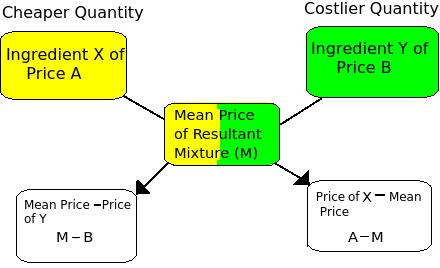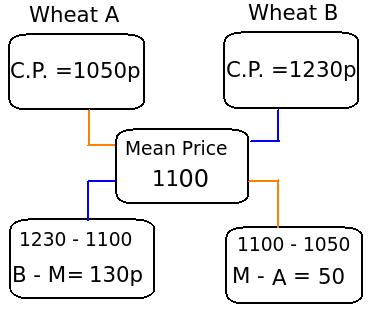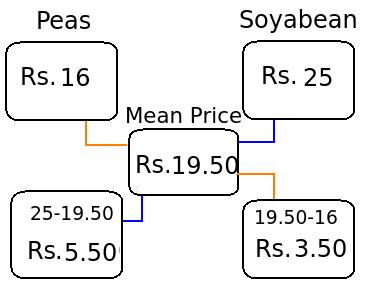Video on Alligation or Mixture - shortcuts, tips and tricksAlligation and Mixtures
Important terms:1) Alligation: Rule of alligation enables us to find the ratio in which two or more ingredients at a given price must be mixed to produce a resultant mixture of desired price.
2) Mean Price: It is the cost of unit quantity of a mixture.
3) Mixture: Mixture is formed by mixing two or more quantities. It can be expressed in the form of percentage or ratio.
- 10 % of sugar in water
- A solution of water and sugar is 12 : 20, which means water : sugar = 12 : 20
According to the rule of alligation: When two ingredients are mixed,
| Cheaper Quantity (X) | = | (C.P. of Y) – (Mean Price) |
| (Quantity of Y) | (Mean Price) – (C.P. of X) |
If a vessel contains A liters of milk and if B litres of milk is withdrawn and replaced by water, and again if B litres of mixture is withdrawn and replaced by water and this operation is replaced n times in all, then | (Quantity of milk left after nth operation) | = |  | (A – B) |  | n |
| (Initial quantity of milk) | A |
| Quantity of milk left after nth operation = A x | [A(1 – (B/A))n] |
| A |
Simplified formula to calculate quantity of milk left after n
th operation = [A(1 – (B/A))
n]
Tricks and Tips:1) Rule of alligation:
| Ratio = | (M – B) | = | (B – M) |
| (A – M) | (M – A) |
Points to Remember While Using the Rule of Alligation- The three values alligated should always represent the same variable and should have same units.
- alligation of 3 values of cost gives the ratio in terms of number and vice-versa.
- If two values of cost price and selling price of the mixture are given, then in such cases first calculate the cost price of the mixture and then allegate the 3 values of cost price.
- A and B represent concentration if the numerical is based on mixing of solutions.
Question VarietyType : 1 Based on Rule of Alligation
In what ratio must wheat A at Rs. 10.50 per kg be mixed with wheat B at Rs. 12.30 per kg, so that the mixture be worth of Rs. 11 per kg?
a. 13 : 5
b. 18 : 3
c. 17 : 5
d. 11 : 5
View solutionCorrect option :(a)
Convert Rs into paise, to make the calculation easy

The required ratio = 130 : 50 = 13 : 5
In what ratio must a shopkeeper mix Peas and Soybean of Rs. 16 and Rs. 25 per kg respectively, so as to obtain a mixture of Rs. 19.50 ?
a. 9 : 5
b. 7 : 5
c. 11 : 7
d. 12 : 8
View solutionCorrect option: (c)
Use rule of alligation, to determine the ratio

The required ratio of Soybean and Peas = 5.50 : 3.50 = 11 : 7